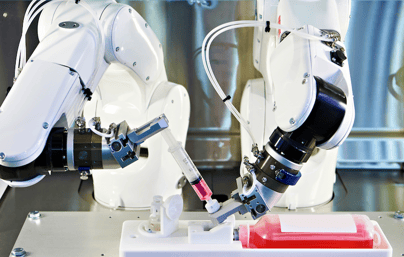Subscribe to the blog
Pharma 4.0: Revolutionizing the Pharmaceutical Industry
May 16, 2023 1:07:12 PM / The Bio-Works Team
Pharma 4.0, the latest buzzword in the pharmaceutical industry, has the potential to transform the industry by making the drug development process faster, more efficient, and more patient-centric. By leveraging advanced technologies such as AI, big data analytics, and IoT, pharmaceutical companies can develop new therapies that are better tailored to individual patient needs, while also reducing costs and improving regulatory compliance. The vision: a faster drug development process that is more efficient and more patient-centric.
The pharmaceutical industry has certainly come a long way since the first synthetic drug, chloral hydrate, was discovered in 1869 and introduced as a sedative-hypnotic.
And even biopharmaceuticals, often hailed as the ”new” therapeutics have made enormous progress since recombinant human insulin was first approved for human therapeutic uses and marketing in 1982.
So much so that today the industry is worth over $1 trillion and employs millions of people worldwide. But despite its success, it has long faced serious challenges in the form of high development costs, lengthy development timelines, and regulatory hurdles. These challenges have had a key driving role towards the emergence of a new approach to drug development known as Pharma 4.0.
What Is Pharma 4.0?
Pharma 4.0 refers to the application of Industry 4.0 technologies to the development and production of pharmaceuticals. It is an approach that seeks to revolutionize the way drugs are developed, produced, and delivered to patients by leveraging cutting-edge technologies such as artificial intelligence (AI), the internet of things (IoT), big data analytics, and cloud computing.

What are the origins of Pharma 4.0, who are its key stakeholders, and what is it expected to bring in the future?
Bringing Industry 4.0 to Pharma
The concept of Pharma 4.0 emerged as an extension of Industry 4.0, the fourth industrial revolution and a term first used in 2011 by a German government initiative to describe progress in manufacturing through digital technologies. Pharma 4.0 was introduced in 2017 by the International Society for Pharmaceutical Engineering to take a holistic approach to this broad initiative in the pharmaceutical sector.
Industry 4.0 represents a paradigm shift in the manufacturing sector, leveraging AI, robotics, and IoT to enable greater efficiency, flexibility, and productivity. It was natural for the pharmaceutical industry, one of the most regulated and complex industries there is, to explore and embrace Industry 4.0 technologies to overcome its challenges and improve the drug development process.
Pharma 4.0 is a collaborative effort among pharmaceutical companies, technology providers, regulatory bodies, and academia and the concept is gaining momentum.
The stakeholders are as diverse as the challenges
The stakeholders in Pharma 4.0 include pharmaceutical companies, technology providers, regulatory bodies, and academia.
Pharmaceutical companies are key players in the Pharma 4.0 ecosystem
Pharmaceutical companies are making significant investments in digital transformation initiatives to modernize their drug development process and reach the market faster. For example, Pfizer has partnered with IBM Watson to apply AI to drug discovery and accelerate the identification of new drug targets in Immuno-oncology. Similarly, Novartis has teamed up with Microsoft to leverage AI to improve the drug development process but has also established an AI Innovation Lab to empower the use of AI across their business.
Technology providers bring infrastructure and tools
Technology providers such as IBM, Microsoft, and Amazon Web Services (AWS) are providing the technology infrastructure and tools needed to support Pharma 4.0 initiatives. For example, AWS provides cloud-based solutions to a number of pharmaceutical companies to store and analyze the vast amounts of data generated during drug development.
Even regulatory bodies are exploring new technology
Regulatory bodies such as the US Food and Drug Administration (FDA) and the European Medicines Agency (EMA) play a critical role in ensuring the safety and efficacy of pharmaceutical products. These bodies are exploring ways to leverage new technologies such as AI and blockchain to improve their regulatory processes and speed up the approval of new drugs.

Academia are pushing the boundaries ever further
Academia plays a crucial role in advancing Pharma 4.0 through research and development. Universities and research institutions are conducting studies on the use of AI and other advanced technologies in drug discovery and development.
Pharma 4.0 is expected to bring numerous benefits to the pharmaceutical industry:
Faster drug discovery and development
The drug development process is a time-consuming and expensive task. Take for example exploration of the vast chemical space of more than 1060 molecules. This can now be addressed by using AI to recognize lead compounds and provide a quicker validation of the drug target and optimization of the drug design.
AI is already being applied and tested in many aspects of drug discovery, design, chemical synthesis and then further downstream into drug screening (prediction of toxicology, activity, various properties and target identification).
In the area of downstream processing in drug development, it is, for example, becoming possible to dramatically accelerate the path to the manufacturing of new therapeutics. For example, chromatography processes are being simulated, and mechanistic modeling developed.
The entire field of moving process development from in vitro to in silico is progressing rapidly.
Increased efficiency and productivity
Many risks in biomanufacturing come from highly manual processes and paper-based records. We are already seeing the replacement of paper records and manual processes by automation, and robotic aseptic filling, for example, replaces manual filling of drug products. Robotic process automation can also be used to streamline data entry and reduce errors.
 One indication of the progress towards this goal and the sector’s willingness to invest came in 2022 when GlaxoSmithKline announced a new smart manufacturing site in the UK. The fully automated, sustainable facility uses digital technology in a highly advanced technical setting. It holds great promise of maximum efficiency in manufacturing operations with a right-first-time capability, whilst also reducing waste.
One indication of the progress towards this goal and the sector’s willingness to invest came in 2022 when GlaxoSmithKline announced a new smart manufacturing site in the UK. The fully automated, sustainable facility uses digital technology in a highly advanced technical setting. It holds great promise of maximum efficiency in manufacturing operations with a right-first-time capability, whilst also reducing waste.
Across the board, Pharma 4.0 initiatives are expected to help pharmaceutical companies reduce costs by improving efficiency, reducing waste, and optimizing resource allocation.
Improved regulatory compliance
Pharma 4.0 initiatives can help pharmaceutical companies comply with increasingly stringent regulatory requirements by improving data quality, accuracy, and transparency. For example, blockchain technology can be used to create an immutable record of all transactions related to a clinical trial, ensuring that data is secure and cannot be tampered with.
Improved patient outcomes
Pharma 4.0 initiatives can help in the development of more targeted therapies that are tailored to individual patient needs. By using data from electronic health records, wearables, and other sources, researchers can identify patient subgroups that respond to a particular treatment, which holds the promise of better treatment outcomes and fewer adverse effects.
Clinical trials are becoming more inclusive and more diverse driven by a new generation of precise and personalized therapies.
The need for more patient-centered outcomes and quality results from clinical trials means that patient engagement is becoming more crucial. Digital tools can greatly facilitate patient participation and real-time reporting of side effects or lifestyle factors, and user-friendly ePRO and eConsent systems are already becoming game changers.
With the increase in adoption of decentralized clinical trials and the ensuing demand for accessibility, flexibility, and speed, there is a great demand for digital tools to support trials needs to become more seamless and mobile. By sharing data and insights more effectively, different stakeholders in the entire process, including researchers, clinicians, regulators, and patients, can work together to optimize clinical trial design, and ensure that drugs are developed in a more patient-centric manner.
Management of more complex portfolios
The emergence of an increasingly diverse range of new biotherapeutics creates a need for more sophisticated controls in manufacturing and the greater flexibility, adaptive process control and real-time decision-making that digital solutions can provide. Companies will need to manage multiple critical quality attributes in a more and more complex product and modality portfolio.
Creating smarter manufacturing will allow pharma manufacturers to become flexible and competitive and adapt to market and regulatory changes, as well as accommodate more personalized medicine requirements.
Bringing everyone together
Arguably one of the most powerful changes that digitalization could bring about is the creation of a more holistic mode of pharma manufacturing. Pharma’s highly regulated environment requires a high level of oversight at every stage and this has created data silos, scaling difficulties, and inefficient operations.
Industry 4.0 has the potential to connect all stakeholders and reinforce data-driven decisions across an organization. Removing data silos could create new levels of transparency, control, and rapid and informed decision-making.
The healthcare sector in many countries is facing several complex challenges such as increased cost of drugs and therapies, and society needs significant changes in this area.
With Pharma 4.0 we may be on the way.